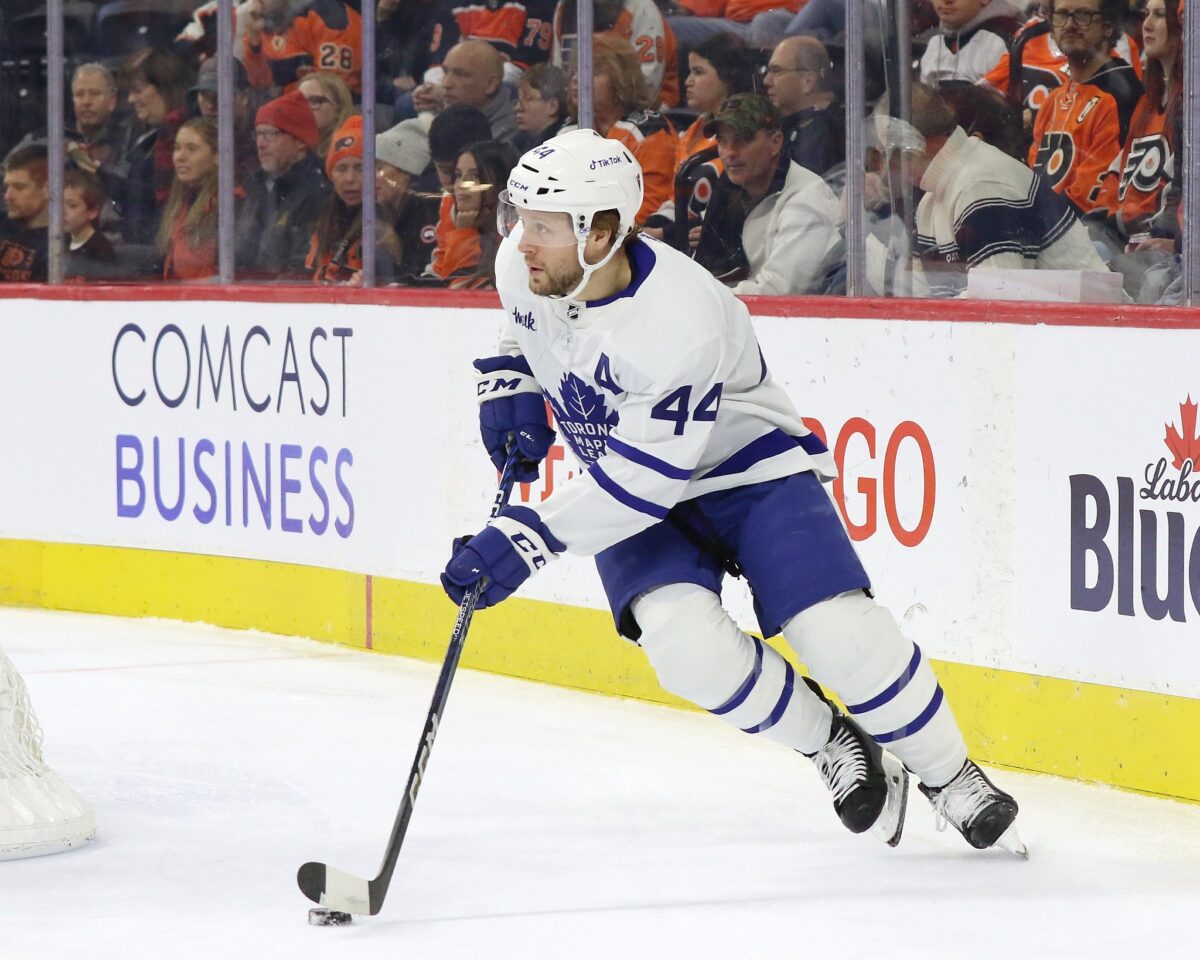Morgan Rielly, one of the league’s premier puck-moving defencemen, enjoyed a third-straight 40-plus point campaign as the Toronto Maple Leafs’ bona fide number-one blueliner. While his regular season performance was a bit of a step backward individually, he certainly turned it up a notch in the postseason, proving that he’s still capable of munching tough minutes with great success when it matters most.
Regular Season
It’s tough to be the only apt puck-moving defenceman on one’s team, and in Rielly’s case, it certainly held him back from success in 2023-24 — the first season in which he was truly the lone puck-mover on the back end. From 2021-23, Rasmus Sandin, for all his faults while playing in the blue and white, was a solid enough puck-mover to take some of that pressure away from Rielly, and before that, there were the likes of Tyson Barrie, Jake Gardiner, and even Jake Muzzin, who were all able to move the puck up-ice in transition. Rielly felt the full pressure of being the only defenceman able to truly transition the puck from defence to offence, and his underlying statistics took a hit because of it.
Related: Toronto Maple Leafs 2023-24 Report Card: Timothy Liljegren
While his point totals are more than respectable — his 58 points in 72 games ranked 11th in the NHL among defencemen — his expected goals share (xGF%) dropped below 50% for the first time since 2017-18. In fact, his xGF% of 49.05% was the worst among regular Maple Leafs defencemen and just barely surpassed that of Ryan Reaves‘ 48.92%, putting Rielly at 18th on the team. Nothing was out of the ordinary in terms of offensive instinct — his expected goals for per 60 minutes (xGF/60) ranked middle-of-the-pack relative to other Maple Leafs skaters — but his defensive game was nonexistent, holding by far the worst expected goals against per 60 minutes (xGA/60) among defencemen and ranking better than Noah Gregor alone in that metric.

It’s admittedly difficult to put the blame on Rielly for this two-way impact dropoff, as the team constructed around him inherently put a ton of pressure on him to carry the bulk of puck-moving, transitional work on defence. The next-best option in that regard is probably Timothy Liljegren, who had a great regular season but certainly isn’t considered a transitional threat. When the vast majority of puck-moving is left to one defenceman, it’s almost a sure shot that other teams take notice and increase the forechecking pressure on said defenceman.
If there was another blueliner capable of transitioning the puck up-ice, I’m sure Rielly’s impacts would have seen drastic improvement. Even if John Klingberg had played the full season, it’s almost a sure thing that Rielly would have been better off for it regardless of how successful Klingberg had been. He wasn’t healthy, though, and reminiscing on what could have happened takes away from the fact that Rielly’s season was subpar relative to what we’ve become accustomed to.
2023-24 Regular Season Grade: B-
Playoffs
In the playoffs, however, Rielly turned it up a notch, firmly cementing himself as a premier defenceman in this league come crunch time. He led the team in time on ice, registering nearly 132 minutes of 5v5 hockey in seven games — almost 14 minutes more than the next-highest player (Jake McCabe). Even despite the heavy minutes against tough opposition, Rielly’s 54.89% xGF% was firmly the best on the team. His xGF/60 of 3.20 was miles better than any other defenceman (Ilya Lyubushkin at 2.99 was second), and he didn’t have to sacrifice any defence to get the offensive statistics going, either, placing 12th among 21 skaters in terms of xGA/60. The Maple Leafs generated a better high-danger chance share (HDCF%) with Rielly on the ice than any other player in the postseason.
The points might not have been there, with just three assists in those seven games, but there’s no denying that he was dominant at 5v5 and inarguably the Maple Leafs’ most important defenceman in the postseason. Eating up nearly 25 minutes a night against the Boston Bruins’ best while maintaining the best xGF% and HDCF% on the team and drastically increasing his physicality is exactly why Rielly gets paid $7.5 million annually, and with an improved puck-moving defence corps alongside him in 2024-25, his regular season metrics should look a lot more as they did in the 2024 Playoffs than they did in the 2023-24 regular season.
2024 Playoffs Grade: A
Maple Leafs Were Wise to Increase Puck-Moving Skill
The Maple Leafs added two key pieces to their defence corps for the 2024-25 season: Chris Tanev and Oliver Ekman-Larsson. Tanev, while primarily known for his stalwart defensive game, is an underrated puck-mover and should alleviate some of the stress from Rielly, who is almost certainly going to start the season as his defence partner. As if that wasn’t enough to improve Rielly’s prospective impacts, Ekman-Larsson was one of the league’s most underrated and effective transitional defencemen last season and will do wonders on Toronto’s second pair in terms of being a playmaking and puck-moving threat. Look for Rielly to build upon his magnificent, albeit short, playoff stretch with what should be one of the best puck-moving defence corps that the Maple Leafs have had in recent memory.
